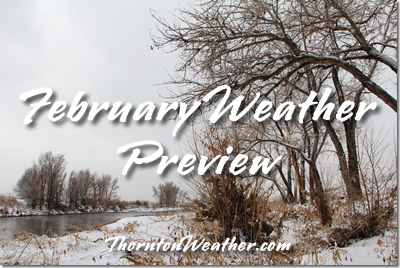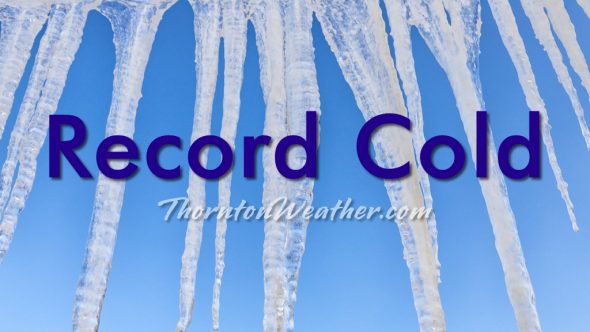
You just never know what you are going to get with the weather in Denver and we see that in our look back at the Denver weather history books. From cold and snow to damaging winds and spring-like temperatures, we can and do see it all.
From the National Weather Service:
26-1
In 1888…a protracted warm spell lasted a week. Maximum temperatures ranged from 62 degrees on the 29th to an all time record high for the month of 76 degrees on the 27th. Daily record high temperatures of 76…69…and 71 occurred on the 27th…28th…and 30th respectively. Record high minimum temperatures of 47 and 34 occurred on the 26th and 27th.
27-31
In 1951…a major storm dumped 10.1 inches of snowfall at Stapleton Airport. Most of the snow…8.3 inches…fell on the 29th. Cold arctic air accompanied the snow. Several temperature records were set…including record low maximum temperatures of 4 on the 28th and 4 below zero on the 29th and record low temperatures of 12 below zero on the 29th and 24 below zero on the 31st. Temperatures were below zero for 45 consecutive hours.
28-29
In 1956…snowfall totaled 5.5 inches at Stapleton Airport where east winds gusted to 32 mph on the 28th.
In 1972…cold west winds buffeted Boulder. A wind gust to 92 mph was recorded at the National Bureau of Standards…while a gust to 76 mph was measured in downtown Boulder. Two mobile homes were overturned in Boulder. Other damage was minor. Northwest winds gusted to 40 mph at Stapleton International Airport on the 28th.
In 1987…strong winds buffeted the Front Range foothills and spread east over the plains. The highest wind recorded was 99 mph on the 29th at both the National Center for Atmospheric Research in Boulder and the Rocky Flats plant south of Boulder. Wind gusts in excess of 80 mph were common. A northwest wind gust to 54 mph was recorded at Stapleton International Airport on the 28th with a gust to 41 mph on the 29th. Planes were damaged at both the Boulder and Jefferson County Airports. Hangars were also damaged at Jefferson County Airport. Many windows were broken…signs toppled…and trees downed. A brick wall was blown onto parked cars in Lakewood. A couple of houses in Lakewood were unroofed…while falling trees damaged others. Two people were injured by flying debris in Lakewood and Golden. Total insured damage along the Front Range was 10 million dollars making the wind storm the second most costly on record in Colorado at the time.
In 1995…deepening upslope winds along the eastern foothills on the 28th gave way to periods of heavy snow during the night and early morning hours of the 29th. Snow fell to a depth of 8 inches in both Golden and Boulder with up to a foot in the foothills. Only 1.9 inches of snow fell at Stapleton International Airport…where east winds gusted to 22 mph on the 28th.
In 2001…heavy snow fell across metro Denver. The heaviest snowfall occurred from just south of Denver to around Castle Rock. Snow amounts included: 12 inches east of Parker…9 inches near Elizabeth and in Littleton…8 inches near Castle Rock and in Parker…and 7 inches in Aurora. Snowfall totaled 6.0 inches at the site of the former Stapleton International Airport.
28-30
In 1887…winds were strong and gusty for three days in the city. West and northwest winds were sustained to 56 mph on both the 28th and 29th and to 44 mph on the 30th. Temperatures warmed to a high of 57 degrees on the 29th.
29
In 1900…northwest winds were sustained to 45 mph with an extreme velocity of 46 mph.
In 1914…this was the last day of 60 consecutive days with snow cover of one inch or more in Denver. This third longest period of snow cover on record began with the record breaking snow and blizzard on December 1-5… 1913 when a total of 45.7 inches of snow fell in downtown Denver. Additional snowfall during December and January prolonged the event. Snow depth on the ground to the nearest tenth of an inch was measured once daily at 6:00 pm MST.
In 1927…west winds were sustained at 40 mph with gusts to 42 mph.
In 1942…heavy snowfall totaled 6.2 inches in downtown Denver. North winds were sustained to 17 mph.
In 1965…strong winds occurred in Boulder for the third consecutive day. Only limited minor damage was reported. Northwest winds gusted to 40 mph at Stapleton International Airport.
In 1984…highs winds in and near the foothills produced wind gusts as high as 71 mph in Boulder. A plane was flipped over at Jefferson County Airport and damaged beyond repair. In Lakewood…two construction trailers were damaged by the gusts. North winds gusted to only 38 mph at Stapleton International Airport.
In 1990…gale to hurricane force winds gusts raked the foothills. Wind gusts of 50 to 90 mph were common in Boulder County. A peak wind of 94 mph was clocked at Table Mesa in southwest Boulder. Scattered power outages and minor property damage were reported. West winds gusted to 46 mph at Stapleton International Airport.
29-30
In 1985…an arctic air mass with snow closed I-70 for a time in Denver and east of Denver. Snowfall totaled 5.4 inches at Stapleton International Airport where north winds gusted to 29 mph on the 29th.
29-31
In 1883…a major winter storm dumped 19.3 inches of snow on downtown Denver. Most of the snow…12.2 inches…fell on the 31st. This was the heaviest snowfall to hit the city in years. Temperatures plunged from a high of 52 degrees on the 29th to a low of 13 degrees on the 31st. Precipitation from the storm totaled 2.23 inches. The 1.22 inches of precipitation on the 31st was the greatest calendar day and 24 hour precipitation ever recorded in the city during the month of January.
30
In 1886…west winds were sustained to 42 mph and were the strongest winds of the month that year. The winds warmed the temperature to a high of 52 degrees in the city.
In 1890…west winds were sustained to 40 mph with gusts to 48 mph in the city.
In 1971…a wind gust to 102 mph was recorded in Boulder at the National Center for Atmospheric Research. Elsewhere in Boulder…winds gusted to 76 mph. Northwest winds gusting to 46 mph at Stapleton International Airport warmed temperatures to a high of 66 degrees.
In 1976…a rapid moving cold front produced wind gusts 50 to 70 mph causing visibilities to be reduced to less than 1/2 mile in blowing dust for 1 to 2 hours closing some major highways. A north wind gust to 55 mph was recorded at Stapleton International Airport.
In 2003…strong winds developed in and near the foothills. Recorded wind gusts included: 86 mph near Rollinsville… 76 mph in Evergreen…and 75 mph in central Boulder. West winds gusted to 43 mph at Denver International Airport.
In 2018…high winds occurred in and near the Front Range Foothills. Peak wind gusts included: 101 mph atop Berthoud Pass; 97 mph near Gold Hill; 80 mph at the NCAR Mesa Lab southwest of Boulder and near the former Rocky Flats site; with 75 mph near Nederland. The high winds toppled a large tree at the mouth of Boulder Canyon.
30-31
In 1908…an apparent strong cold front plunged temperatures 45 degrees in 24 hours from 47 degrees at noon on the 30th to only 2 degrees at noon on the 31st. North winds were sustained to 30 mph on the 30th. Snowfall was only 0.8 inch on the 31st.
In 1965…a major storm dumped 10.4 inches of snow over metro Denver. After 5 inches of snow fell in Boulder… Strong Chinook winds developed…warming the temperature 25 degrees in 90 minutes. Wind gusts to 97 mph were recorded on Table Mountain in Boulder. Winds gusts to 53 mph were measured in downtown Boulder where some damage occurred. Minor wind damage also occurred in western suburbs of Denver. West winds gusted to 51 mph at Stapleton International Airport on the 31st.
In 2005…a winter storm brought heavy snow to the Front Range foothills. Storm totals included: 17 inches at Aspen Springs…13 inches 7 miles southwest of Boulder and at Lake Eldora…12.5 inches near Blackhawk…11.5 inches at Rollinsville and near Nederland…11 inches near Evergreen and Golden and at Gross Reservoir…and 10 inches at cabin creek. Lesser amounts of snow fell over the city. Only 1.9 inches of snow were measured overnight at Denver Stapleton. North winds gusted to 30 mph at Denver International Airport…where freezing fog during the early morning of the 30th reduced the surface visibility to as low as 1/8 mile. Light rainfall… Rare in January…totaled 0.06 inch at Denver Stapleton on the early morning of the 30th.
30-7
In 1985…a cold front on the 29th produced a protracted cold spell as arctic air remained entrenched across metro Denver. While the only daily temperature record set was a low maximum reading of 2 degrees on February 3rd…minimum temperatures plunged well below zero on 9 consecutive days. The coldest readings were 15 degrees below zero on January 31st and 14 degrees below zero on February 5th.
31
In 1876…hurricane force winds caused some damage in Boulder.
In 1951…the low temperature plunged to 24 degrees below zero.
In 1933…snowfall was 0.2 inch in downtown Denver. This was the only measurable snowfall of the month and resulted in 0.01 inch of melted snow…the only measurable precipitation of the month.
In 1964…high winds blew down a sidewalk cover where a building was under construction…injuring a young woman. Three men were injured when a brick wall at a construction site toppled on them. All were treated for face…leg…and neck injuries. A west-northwest wind gust to 47 mph was recorded at Stapleton International Airport.
In 1969…high winds struck Boulder with gusts to 115 mph recorded at the National Center for Atmospheric Research and 83 mph in downtown Boulder. Schools were closed because of danger from flying debris. Some damage and minor injuries occurred. Northwest winds gusted to 35 mph at Stapleton International Airport.
In 1985…bitterly cold weather froze pipes and cars and forced some schools to close across metro Denver. Minimum temperatures dipped to as low as 15 below to 20 below zero across metro Denver. The low temperature was 15 below zero at Stapleton International Airport. Continue reading January 29 to February 4: This Week in Denver Weather History →



 February in Colorado typically brings to an end an extended period when average temperatures are at their lowest. Winter begins to loosen its grip and temperatures get warmer but precipitation is not a particularly common event during the month.
February in Colorado typically brings to an end an extended period when average temperatures are at their lowest. Winter begins to loosen its grip and temperatures get warmer but precipitation is not a particularly common event during the month.


